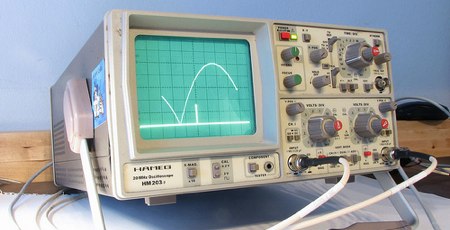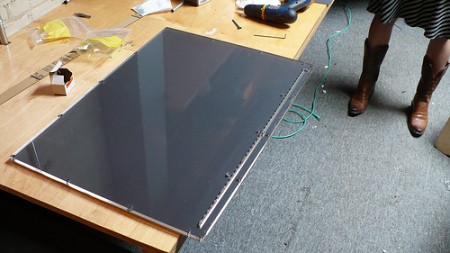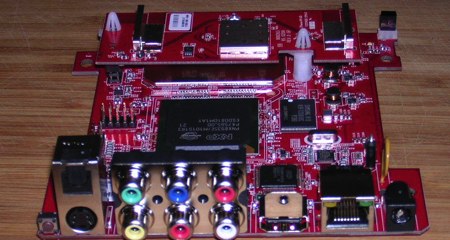
The first video game every created is attributed to physicist William Higinbotham. Tennis for Two is played on an oscilloscope using two controllers. Each one has a knob that controls the trajectory and a button to hit the ball. The fine folks at Evil Mad Scientist Laboratories have recreated the game so you can play it on any oscilloscope. An ATmega168 is used to control everything. It takes user input from the paddles and outputs an the X and Y analog signals for the scope. An R-2R style DAC is used for the output stage which gives a 256×256 resolution. Everything is built on top of one of their business card sized project boards-which really shows how useful such a simple board can be. The source code is free and the write up includes plenty of detail. We’d love to see what modifications people come up with since the base game doesn’t even have scoring. There’s a video of EMSL’s system embedded below.
home entertainment hacks796 Articles
Xbox 360 And LCD HDTV Rolled Into One

What happens when you take a little [Ben Heck] ingenuity, a little Lian Li utility, an Xbox 360 and an LCD HDTV and mix it all together? You get the Microvision 360, a combination LCD HDTV and Xbox 360.
The mod is not particularly complex. The Microvision 360’s creator [PvP_LostKnight] only removed the working parts from the Xbox 360’s case and mounted them to the back of the TV. A few of the inputs of the TV had to be moved and rewired, and a repurposed and painted tupperware container was added to cover the Xbox 360 parts. Unfortunately, [PvP_LostKnight] did not post a writeup, and even added “The wiring for this is horrible, I would not recommend anyone trying this.”
Setting aside his recommendation for a moment, a few of the advantages to his design are improved airflow to the Xbox 360 and better space usage. What we’d like to see added more than anything is power integration, with a single button to turn on both and a single power source powering the TV and the Xbox. See the proof of concept video after the break, or more photos and comments at the read link.
Touchkit – IR Multitouch Screen

If you’ve got an extra grand laying around, you can pre-order one of [nortd]’s touchkits. It features a unique custom made acrylic screen with a crap ton of IR LEDs embedded in it. An included IR camera provides the input and a projector (you get to supply your own) is used to light the surface. We mentioned this in our multitouch roundup and you can find a video of it embedded after the break.
The Rock-afire Explosion Movie Trailer
A small group of enthusiasts have apparently been restoring and reprogramming the animatronic bands from the former Showbiz Pizza Place chain. Original engineer [Aaron Fechter] and car salesman/choreographer [Chris Thrash] have started performing modern pop songs with the bands and have a page where you can bid on new songs to perform. This feels like Billy Bass hacking on a much larger scale. The original machines were controlled by a four track reel, but now they’re using a hard disk recorder. The trailer above is worth watching just for the rows of partially assembled bears performing on the factory floor.
[via Waxy]
ThingamaKIT Video
Bleep Labs has just published a demo video of their new ThingamaKIT that we covered the other day.
Netflix Player Source Code Released

The Netflix Player continues to gain in popularity. Roku has finally released the GPL code for their Netflix Player. Just today Forbes published that Roku would roll out a software update allowing it to stream from other online services. The diminutive device has no internal storage and just enough RAM to buffer the stream. Many have wondered how a Linux box is handling the DRM; this is purely a feature of the NXP PNX8935 processor being used. While waiting for the code, hackers have already popped the box open to see what’s inside. We found [hokiokie7]’s photos of the internals on Roku’s forum. The only really interesting thing we’ve seen so far is that the WiFi is on a daughter card that plugs into the USB. That should make it much easier to support other devices, if users ever manage to get into the system.
UPDATE: [mbailey] points out in the comments that he was able to telnet to the device.
External CD-ROM Turned Class A Headphone Amp

[Gio] sent in this slick Class A headphone amp. An old CD-ROM case was gutted to hold the goods. The design is fairly simple. Cost can be kept fairly low although the capacitors can add up if you’re a fanatic about quality. If you’ve ever lost any of your headphone gear to sticky fingers, you know that having it blending in to the background can be a great feature.










